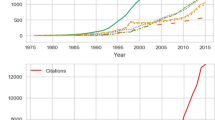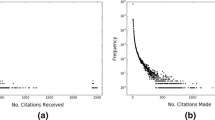Abstract
With the rapid development of 5G technology, studying its evolution path is crucial for innovation and development. This study explores the evolution of 5G technology using patent data analysis. By applying main path analysis and network techniques to a dataset from the IncoPat patent database, the study identifies the main path of 5G technology evolution and analyzes its trends. The Citespace is used to construct citation networks and reveal the main path of the patent citation network, regional citation network, and institutional citation network. Furthermore, the study incorporates the 5G technology lifecycle to dynamically interpret the main path and analyze the major evolution trends of 5G technology. The methodology includes data collection from the IncoPat patent database and the adoption of clustering analysis to identify community structure within citation networks. The Log Likelihood Ratio (LLR) algorithm is employed for community detection, facilitating the analysis of interrelationships among different communities. The main path analysis involves traversal counting and path searching, with the LLR algorithm selected to identify critical nodes in the evolutionary paths of technologies. Additionally, dynamic main path analysis is conducted by incorporating the temporal attribute, enabling the observation of the dynamic changes in technological evolution. The study concludes with important insights into the current development status and evolution of 5G technology, shedding light on key paths and trends in 5G technology evolution.




Similar content being viewed by others
Data Availability
The datasets generated and/or analysed during the current study are available from the corresponding author on reasonable request.
References
Ahonen, T. (2009). Mobile as the 7th of the Mass Media. In Mobile as 7th of the Mass Media (pp. 3–21). Forum Oxford.
Boccardi, F., Heath, R. W. Jr., Lozano, A., Marzetta, T. L., & Popovski, P. (2014). Five disruptive technology directions for 5G. IEEE Communications Magazine, 52(2), 74–80.
Kim, J., Lee, S. H., Jeong, D. G., Kim, S. W., Kim, J. H., & Lee, Y. H. (2017). 5G communication: Evolution and requirements. Journal of Electrical Engineering and Technology, 12(2), 589–595.
Li, C., Qiu, D., Li, B., & Li, G. (2017). 5G wireless communications: Based on existing waveforms or new waveform design? IEEE Communications Magazine, 55(2), 109–115.
Rappaport, T. S., Sun, S., Mayzus, R., Zhao, H., Azar, Y., Wang, K., & Shafi, M. (2013). Millimeter wave mobile communications for 5G cellular: It will work! Ieee Access : Practical Innovations, Open Solutions, 1, 335–349.
Chen, H., Zhao, Y., Zhang, X., & Zhang, J. (2016). Research on key technologies and open issues of 5G networks. Ieee Network, 30(4), 44–51.
Gudipati, S., & Ratasuk, R. (2017). The journey of 5G: Standards, patents, and the future of mobile broadband. IEEE Communications Magazine, 55(1), 176–183.
Ji, Y., Zhang, R., Zhang, T., & Liu, A. (2017). 5G mobile communication networks: A review. Journal of Zhejiang University Science C, 18(3), 243–270.
Osseiran, A., Boccardi, F., Braun, V., Kusume, K., Marsch, P., Maternia, M., & Tullberg, H. (2014). Scenarios for 5G mobile and wireless communications: The vision of the METIS project. IEEE Communications Magazine, 52(5), 26–35.
Giordani, M., Mahmoodi, T., & Tafazolli, R. (2017). Towards 5G tactile internet: Characterizing the human touch. IEEE Communications Magazine, 55(2), 116–123.
Khan, A. U., Ahmed, M., Alnuem, M. A., Ghoneim, A., & Kadir, M. A. (2018). 5G network slicing using SDN and NFV: A survey of taxonomy, architectures and future challenges. Telecommunication Systems, 69(3), 389–416.
Yang, Y., Zhang, L., Zhang, Q., Wang, X., & Wang, K. (2019). Towards intelligent 5G: AI-driven resource allocation and optimization. Ieee Network, 33(2), 70–76.
Chen, J., Zhang, J., Wei, H., & Dai, J. (2023). Frontiers in web-based energy management research: A scientometric data report. Frontiers in Energy Research, 11, 1195243.
Bai, Y., Chou, L., & Zhang, W. (2021). Industrial innovation characteristics and spatial differentiation of smart grid technology in China based on patent mining. Journal of Energy Storage, 43, 103289.
Breschi, S., Lissoni, F., & Malerba, F. (2003). Knowledge-relatedness in firm technological diversification. Research Policy, 32(1), 69–87.
Tang, S., Cai, H.H., Xia, M., Turi, A.N. (2023). The Surge in Blockchain-Based Patent Applications: Booster or Bumps?. In: Turi, A.N. (eds) Financial Technologies and DeFi. Financial Innovation and Technology. Springer, Cham. https://doi.org/10.1007/978-3-031-17998-3_8
Hall, B. H., Jaffe, A. B., & Trajtenberg, M. (2005). Market value and patent citations. The RAND Journal of Economics, 36(1), 16–38.
Li, J., Li, X., Zhang, S., & Zhu, D. (2021). Research on Evolutionary Path of Automobile Technology Based on Patent Data: A Case Study of Chinese Automobile Industry. Complexity, 2021, 6636039.
Zhang, M., Chen, S., & Li, J. (2021). Exploring the evolutionary path of nanotechnology: A patent analysis based on Technology Co-occurrence Network. Journal of Cleaner Production, 312, 127720.
Zhang, Y., Li, G., Yan, Y., Li, W., & Wang, Z. (2021). A patent analysis Method based on hierarchical latent Dirichlet Allocation and Association Rule Network. Ieee Access : Practical Innovations, Open Solutions, 9, 16169–16182.
Li, X., Yin, H., & Yang, L. (2022). Analyzing the evolution path of Artificial Intelligence Technology: A dynamic topic modeling Approach. Ieee Access : Practical Innovations, Open Solutions, 10, 6480–6492.
Zhang, J., Chen, Y., Wei, Y., & Wang, Y. (2021). Technology evolution path analysis based on Technology Entropy Tree: A case study of IT Technology. Journal of Systems Science and Information, 9(5), 59–76.
Qiu, H. H.,Liu LG.A study on the evolution of carbon capture and storage technology based on knowledge mapping[J].Energies,2018,11(5):1103–1104.
Liu, J., Meng, Z., & Jiang, Z. (2017). Synergistic Innovation Research of element-structure-function-cost based on S-Curve. Science and Technology Management Research, 37(16), 146–151.
Zhu, H. (2021). Analysis of 5G Technology Evolution Path from the Perspective of Patent Citation (Master’s thesis, Anhui University of Finance and Economics).
Dahesh, M. B., Tabarsa, G., Zandieh, M., & Hamidizadeh, M. (2020). Reviewing the intellectual structure and evolution of the innovation systems approach: A social network analysis. Technology in Society, 63, 101399.
Narin, F., Hamilton, K. S., & Olivastro, D. (1997). The increasing linkage between US technology and public science. Research Policy, 26(3), 317–330.
Zhang, Y., Chen, X., & Wu, Y. (2020). Identifying technology evolution pathways: A bibliometric analysis based on the main path analysis and patent citation network. Technological Forecasting and Social Change, 151, 119791.
Wang, C., Zhang, X., & Li, Y. (2020). Evolutionary trajectory and path dependency of technological innovation in industrial robot industry: A main path analysis. Technological Forecasting and Social Change, 150, 119756.
Chen, H., Chiang, R. H., & Storey, V. C. (2012). Business intelligence and analytics: From big data to big impact. " MIS Quarterly, 36(4), 1165–1188.
Leydesdorff, L., & Rafols, I. (2009). A global map of science based on the ISI subject categories. Journal of the American Society for Information Science and Technology, 60(2), 348–362.
Wang, X., Chen, H., & Chen, X. (2021). Identifying Emerging Technologies: A text Mining Approach. Journal of Informetrics, 15(1), 101157.
Trajtenberg, M. (1990). A penny for your quotes: Patent citations and the value of innovations. The RAND Journal of Economics, 21(1), 172–187.
Dangi, R., Lalwani, P., Choudhary, G., You, I., & Pau, G. (2021). Study and investigation on 5G technology: A systematic review. Sensors (Basel, Switzerland), 22(1), 26.
Janssens, F., & Huysmans, J. (2019). Unveiling the history of science using citation network analysis: Implementing the dynamic topic model (DTM) on the entire citation network of Nature. Scientometrics, 118(2), 513–538.
Dunning, T. (1993). Accurate methods for the statistics of surprise and coincidence. Computational Linguistics, 19(1), 61–74.
Chen, C. (2006). CiteSpace II: Detecting and visualizing emerging trends and transient patterns in scientific literature. Journal of the American Society for Information Science and Technology, 57(3), 359–377.
Brandes, U., & Corman, S. R. (2003). Visual unrolling of network evolution and the analysis of dynamic discourse. Journal of Social Structure, 4(2), 1–29.
Batagelj, V., & Mrvar, A. (2002). Pajek: Program for large network analysis. Connections, 24(2), 47–57.
Narayanan, A., Ramadan, E., Carpenter, J., Liu, Q., Liu, Y., Qian, F., & Zhang, Z. L. (2020, April). A first look at commercial 5G performance on smartphones. In Proceedings of The Web Conference 2020 (pp. 894–905).
Banaseka, F. K., Katsriku, F., Abdulai, J. D., Adu-Manu, K. S., & Engmann, F. N. A. (2021). Signal propagation models in soil medium for the study of wireless underground sensor networks: A review of current trends. Wireless Communications and Mobile Computing, 2021, 1–12.
Sodhro, A. H., Obaidat, M. S., Abbasi, Q. H., Pace, P., Pirbhulal, S., Fortino, G.,… Qaraqe, M. (2019). Quality of service optimization in an IoT-driven intelligent transportation system. IEEE Wireless Communications, 26(6), 10–17.
Funding
This study was supported by the Shaoxing City Philosophy and Social Science Research ‘14th Five-Year’ Plan 2023 Key Project: A Study on the Implementation Path of Rural Revitalization Empowered by Digital Transformation under the ‘Two Mountains’ Theory from the Perspective of ‘Green Common Prosperity’ – A Case Study of Zhejiang Shaoxing (Project Number: 145J073)
Author information
Authors and Affiliations
Corresponding author
Ethics declarations
Conflict of interest
Author Biqiang Han declares that she has no conflict of interest. Author Helen Huifen Cai declares that he has no conflict of interest. Author Mengyao Xia declares that he has no conflict of interest. Author Jie Zhang declares that he has no conflict of interest. Author Yan Tu declares that he has no conflict of interest. Author Jiao Wu declares that she has no conflict of interest.
Ethical approval
This article does not contain any studies with human participants or animals performed by any of the authors.
Informed consent
Not Applicable.
Additional information
Publisher’s Note
Springer Nature remains neutral with regard to jurisdictional claims in published maps and institutional affiliations.
Rights and permissions
Springer Nature or its licensor (e.g. a society or other partner) holds exclusive rights to this article under a publishing agreement with the author(s) or other rightsholder(s); author self-archiving of the accepted manuscript version of this article is solely governed by the terms of such publishing agreement and applicable law.
About this article
Cite this article
Han, B., Zhang, J., Cai, H. et al. 5G wireless technology evolution: identifying evolution pathways of core technologies based on patent networks. Wireless Netw 30, 6875–6886 (2024). https://doi.org/10.1007/s11276-023-03538-8
Accepted:
Published:
Issue Date:
DOI: https://doi.org/10.1007/s11276-023-03538-8




